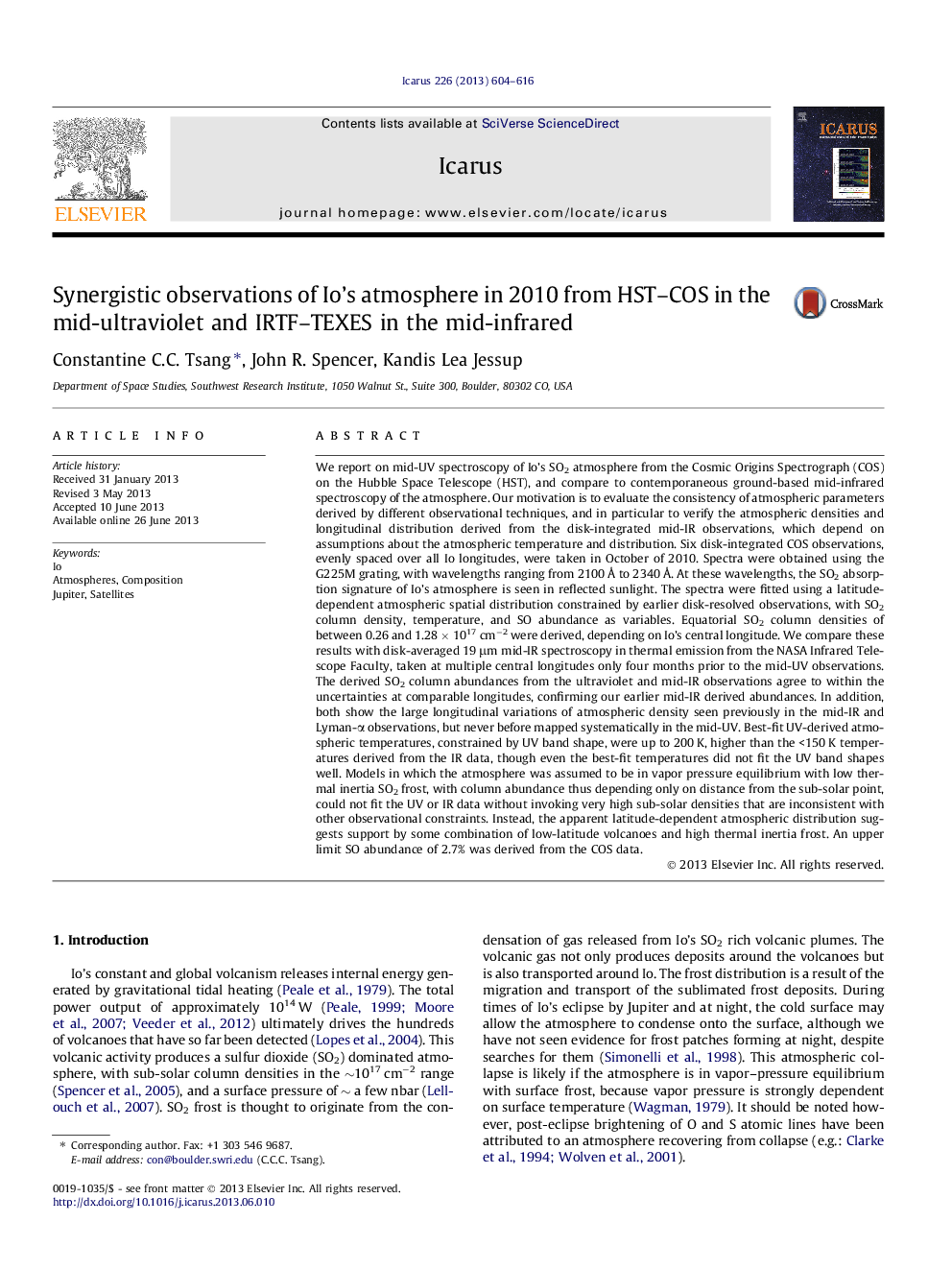| کد مقاله | کد نشریه | سال انتشار | مقاله انگلیسی | نسخه تمام متن |
|---|---|---|---|---|
| 10701327 | 1021128 | 2013 | 13 صفحه PDF | دانلود رایگان |
عنوان انگلیسی مقاله ISI
Synergistic observations of Io's atmosphere in 2010 from HST-COS in the mid-ultraviolet and IRTF-TEXES in the mid-infrared
دانلود مقاله + سفارش ترجمه
دانلود مقاله ISI انگلیسی
رایگان برای ایرانیان
موضوعات مرتبط
مهندسی و علوم پایه
علوم زمین و سیارات
علوم فضا و نجوم
پیش نمایش صفحه اول مقاله

چکیده انگلیسی
We report on mid-UV spectroscopy of Io's SO2 atmosphere from the Cosmic Origins Spectrograph (COS) on the Hubble Space Telescope (HST), and compare to contemporaneous ground-based mid-infrared spectroscopy of the atmosphere. Our motivation is to evaluate the consistency of atmospheric parameters derived by different observational techniques, and in particular to verify the atmospheric densities and longitudinal distribution derived from the disk-integrated mid-IR observations, which depend on assumptions about the atmospheric temperature and distribution. Six disk-integrated COS observations, evenly spaced over all Io longitudes, were taken in October of 2010. Spectra were obtained using the G225M grating, with wavelengths ranging from 2100Â Ã
to 2340Â Ã
. At these wavelengths, the SO2 absorption signature of Io's atmosphere is seen in reflected sunlight. The spectra were fitted using a latitude-dependent atmospheric spatial distribution constrained by earlier disk-resolved observations, with SO2 column density, temperature, and SO abundance as variables. Equatorial SO2 column densities of between 0.26 and 1.28 Ã 1017 cmâ2 were derived, depending on Io's central longitude. We compare these results with disk-averaged 19 μm mid-IR spectroscopy in thermal emission from the NASA Infrared Telescope Faculty, taken at multiple central longitudes only four months prior to the mid-UV observations. The derived SO2 column abundances from the ultraviolet and mid-IR observations agree to within the uncertainties at comparable longitudes, confirming our earlier mid-IR derived abundances. In addition, both show the large longitudinal variations of atmospheric density seen previously in the mid-IR and Lyman-α observations, but never before mapped systematically in the mid-UV. Best-fit UV-derived atmospheric temperatures, constrained by UV band shape, were up to 200 K, higher than the <150 K temperatures derived from the IR data, though even the best-fit temperatures did not fit the UV band shapes well. Models in which the atmosphere was assumed to be in vapor pressure equilibrium with low thermal inertia SO2 frost, with column abundance thus depending only on distance from the sub-solar point, could not fit the UV or IR data without invoking very high sub-solar densities that are inconsistent with other observational constraints. Instead, the apparent latitude-dependent atmospheric distribution suggests support by some combination of low-latitude volcanoes and high thermal inertia frost. An upper limit SO abundance of 2.7% was derived from the COS data.
ناشر
Database: Elsevier - ScienceDirect (ساینس دایرکت)
Journal: Icarus - Volume 226, Issue 1, SeptemberâOctober 2013, Pages 604-616
Journal: Icarus - Volume 226, Issue 1, SeptemberâOctober 2013, Pages 604-616
نویسندگان
Constantine C.C. Tsang, John R. Spencer, Kandis Lea Jessup,